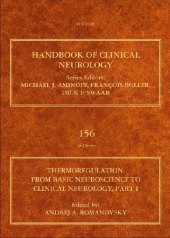 Neuerscheinungen 2018Stand: 2020-02-01 |
Schnellsuche
ISBN/Stichwort/Autor
|
Herderstraße 10
10625 Berlin
Tel.: 030 315 714 16
Fax 030 315 714 14
info@buchspektrum.de |

Andrej A. Romanovsky
Thermoregulation Part I
From Basic Neuroscience to Clinical Neurology
Herausgegeben von Romanovsky, Andrej A.
2018. 496 S. 276 mm
Verlag/Jahr: ELSEVIER 2018
ISBN: 0-444-63912-8 (0444639128)
Neue ISBN: 978-0-444-63912-7 (9780444639127)
Preis und Lieferzeit: Bitte klicken
Thermoregulation, Part I: From Basic Neuroscience to Clinical Neurology, Volume 154, not only reviews how body temperature regulation changes in neurological diseases, but also how this aspect affects the course and outcomes of each disease. Other sections of the volume review three therapeutic approaches that are aimed at manipulating body temperature, including induced hypothermia, induced hyperthermia and antipyretic therapy. The book is comprised of nine sections across two volumes, five dealing with the basic aspects of body temperature regulation and four dealing with the clinical aspects. Basic sections cover the Thermoregulation system, Thermoreceptors, Thermoeffectors, Neural pathways, and Thermoregulation as a homeostatic function.
In addition, the book covers the physiology and neuroanatomy of the thermoregulation system and provides descriptions of how the regulation of body temperature intervenes with other physiological functions (such as sleep, osmoregulation, and immunity), stress, exercise and aging. Basic sections serve as an introduction to the four clinical sections: Body Temperature, Clinical Significance, Abnormal Body Temperature, Thermoregulation in Neurological Disease and Therapeutic Interventions.
Presents a clear, logical pathway from the fundamental physiology of thermoregulation, through neurobiology, to clinical applications and disease
Enables researchers and clinicians to better understand the value of temperature measurement in disease and the use of temperature as a therapy
Integrates content from a broad field of research, including topics on the molecular physiology of temperature receptors, to the management of accidental hypothermia
SECTION I. THERMOREGULATION SYSTEM 1. The thermoregulation system and how it works
SECTION II. THERMORECEPTORS 2. Peripheral thermoreceptors in innocuous temperature detection 3. Molecular basis of peripheral innocuous cold sensitivity 4. Molecular basis of peripheral innocuous warmth sensitivity 5. Peripheral and central determinants of skin wetness sensing in humans 6. Nociceptors. Thermal allodynia and thermal pain 7. Central thermoreceptors 8. Molecular Basis of Central Thermosensation
SECTION III. THERMOEFFECTORS 9. Brown adipose tissue as a heat-production thermoeffector 10. Shivering and nonshivering thermogenesis in skeletal muscles 11. Skin vasoconstriction as a heat-conservation thermoeffector 12. Cutaneous active vasodilation as a heat-loss thermoeffector 13. Sweating as a heat-loss thermoeffector 14. Panting as a heat-loss thermoeffector 15. Thermal comfort
SECTION IV. NEURAL PATHWAYS 16. Afferent pathways for autonomic and shivering thermoeffectors 17. Efferent neural pathways for the control of brown adipose tissue thermogenesis and shivering 18. Efferent thermoregulatory pathways regulating cutaneous blood flow and sweating 19. Central neural substrates involved in temperature discrimination, thermal pain, thermal comfort, and thermoregulatory behavior
SECTION V. THERMOREGULATION AS A HOMEOSTATIC FUNCTION 20. Body temperature and sleep 21. Skin Temperature, Sleep and Vigilance 22. Thermoregulation and the ultradian basic rest-activity cycle 23. Thermoregulation and age 24. Temperature and adaptive immunity 25. Interactions between body fluid homeostasis and thermoregulation in humans 26. Obesity and Thermoregulation 27. Thermoregulation and nausea 28. Neurogenesis in the thermoregulatory system
".The book excels with comprehensiveness, completeness, adequate width and depth, homogeneity, clarity, and actuality, not to forget the great number of illustrative and helpful figures. It presents a clear, logical pathway from the fundamental physiology of thermoregulation, through neurobiology, to clinical applications and disease. Undoubtedly, it will become a must for physiologists, biologists, neurologists, anesthesiologists and all clinicians whose clinical focus includes temperature control, as e.g. in internal medicine and endocrinology."
~ Jürgen Werner, Book Review: "Thermoregulation: From Basic Neuroscience to Clinical Neurology, Part 1", in Temperature, Volume 5, Issue 3, 2018. Taylor & Francis Online.


